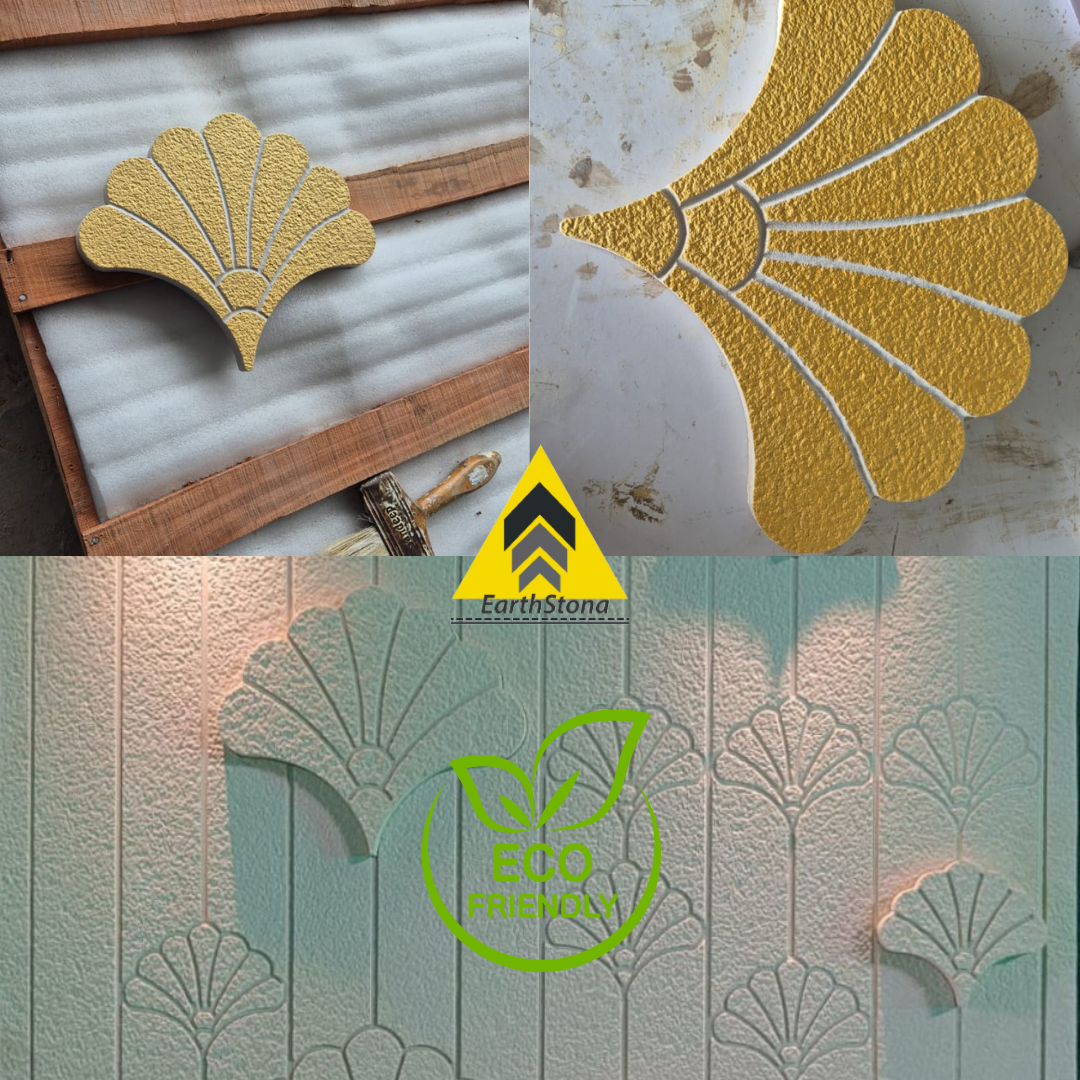- Login
- Register
Eco-Friendly Building Materials

Why Stone is Making a Comeback
In today’s construction and design world, sustainability is becoming a driving force behind material choices. Among the many materials considered eco-friendly, natural stone is gaining renewed attention. This blog will explore why stone is making a comeback as an eco-friendly building material and how it can be integrated into modern design with applications like stone cladding, stone murals, and stone carvings.
1. The Growing Need for Sustainable Materials
With growing awareness of climate change and environmental degradation, both industries and consumers are gravitating toward sustainable practices. Construction materials that minimize environmental impact are highly sought after, and natural stone is gaining recognition for its eco-friendly benefits.
What makes stone eco-friendly?
Abundant and Natural Resource: Stone is readily available in nature and doesn’t require complex processing like synthetic materials.
Minimal Manufacturing Impact: Unlike other building materials such as concrete or plastic, stone requires little to no industrial processing. Quarrying and cutting are simpler and consume less energy compared to the production of materials like steel or glass.
Durability and Longevity: Stone lasts for centuries. Buildings made of stone often stand the test of time, reducing the need for replacements and waste in the long run.
Recyclable: Natural stone can be reused, repurposed, or recycled for other applications. It reduces the dependency on new raw material extraction.
2. The Versatility of Stone in Modern Architecture
One of the reasons for stone’s resurgence is its versatility in design. Not only can stone serve structural purposes, but it can also be an artistic and decorative element in both interior and exterior spaces. Let’s dive into some popular applications:
Stone Cladding
What is Stone Cladding?
Stone cladding refers to applying a thin layer of natural stone to a building’s walls or structures for aesthetic purposes. It’s an excellent way to enhance a building’s visual appeal while retaining eco-friendly properties.
Advantages of Stone Cladding:
Insulation: Stone cladding adds an extra layer of insulation, reducing energy consumption for heating or cooling.
Low Maintenance: It requires minimal upkeep and doesn’t degrade quickly.
Variety of Finishes: You can find cladding in granite, limestone, slate, and other stones, each offering a unique look and texture.
Application: Interior, exterior, living area, dinning area, front elevations, doundary wall area, double height staircase wall, drawing room wall highlight, dinning wall, bedroom wall carving, customized stone carving designs for big walls in houses.
Using stone cladding, both modern homes and commercial spaces can achieve a timeless aesthetic with contemporary design.
Stone Murals
What is a Stone Mural?
Stone murals are large, intricately carved stone designs often used as decorative wall art. These are common in both residential and public buildings, giving spaces an artistic touch that’s in harmony with nature.
Why Choose Stone Murals?
Unique Aesthetic: No two pieces of stone are identical, ensuring that each mural is one-of-a-kind.
Durable Art: Unlike other materials, stone murals are highly resistant to weather and age gracefully.
Timeless Elegance: Stone murals add a classical touch to any space and can be integrated into both traditional and modern designs.
Stone murals can be featured in prominent areas like building facades, lobbies, or interior walls, elevating the sense of luxury and permanence in the space.
Stone Carvings and 3D Wall Art
Stone carvings and 3D wall art are another form of design that’s making waves in the modern architectural world.
3D Wall Art in Stone: By creating three-dimensional art out of stone, designers can craft dynamic and textured spaces. Stone carvings can depict anything from abstract forms to traditional motifs, offering flexibility in aesthetic appeal.
Stone Carvings: Historically, stone carvings have been associated with sculptures and monuments. Today, they are being incorporated into interior spaces, such as feature walls in living rooms or courtyards.
Why Incorporate Stone Carvings?
Art Meets Architecture: Stone carvings seamlessly combine form and function, adding depth to walls and surfaces.
Durability: Like stone cladding and murals, stone carvings are long-lasting and can withstand weather changes, making them ideal for both indoor and outdoor spaces.
3. Stone’s Eco-Friendly Benefits in Comparison to Other Materials
While other materials like concrete, plastic, or metal may be cheaper and faster to produce, they have several environmental downsides, such as high carbon emissions, non-recyclability, or toxicity. In contrast, stone has numerous eco-friendly advantages.
Lower Energy Footprint: The energy required to quarry, cut, and shape stone is significantly lower compared to manufacturing materials like cement or glass. Quarrying is a mechanical process with minimal chemical involvement, reducing carbon emissions.
Minimal Waste: Most natural stone quarries aim to utilize the entire stone mass, leaving very little waste. Even the stone dust produced during cutting can be repurposed for landscaping or as an aggregate in concrete.
No Harmful Chemicals: Stone does not off-gas or emit harmful VOCs (Volatile Organic Compounds), making it a healthy choice for indoor environments.
4. Enhancing Energy Efficiency with Stone
Another reason stone is making a comeback is its contribution to energy-efficient building design.
Thermal Mass: Stone has excellent thermal mass, meaning it absorbs heat during the day and releases it slowly at night. This property helps regulate indoor temperatures and reduces the need for heating or cooling systems, resulting in energy savings.
Durability Reduces Resource Use: Buildings made from stone last longer and require less frequent repairs, replacements, or updates, which means fewer resources are consumed over the building’s lifespan.
5. The Aesthetic and Functional Benefits of Stone in Urban Spaces
As urban areas become more densely populated, city planners and architects are looking for materials that are not only sustainable but also aesthetically pleasing. Stone meets both these needs.
Urban Revitalization with Stone: In urban design, stone is being used to rehabilitate older buildings while preserving their heritage. Stone cladding can help refurbish older concrete structures and add modernity without sacrificing the building’s structural integrity.
Green Building Certifications: Incorporating natural stone into design can help builders achieve green certifications, such as LEED (Leadership in Energy and Environmental Design). The use of stone aligns with the principles of sustainable architecture and design, such as energy efficiency, material durability, and environmental harmony.
6. Challenges and Opportunities for Stone in Sustainable Construction
Though stone is eco-friendly in many ways, it’s not without challenges. Quarrying and transporting stone can result in environmental disruption and carbon emissions if not managed properly. However, advancements in quarrying techniques and the increasing focus on local sourcing have mitigated these issues.
Opportunities:
Local Sourcing: Using locally sourced stone can reduce the carbon footprint associated with transportation, making stone even more eco-friendly.
New Technologies: Innovations in stone cutting and carving are reducing waste and energy consumption during production.
Conclusion: The Timeless and Sustainable Nature of Stone
As sustainability becomes a top priority in construction, natural stone is making a strong comeback. Its eco-friendly attributes, such as durability, recyclability, and energy efficiency, make it a valuable material in modern building practices. Moreover, its versatility in design—whether through stone cladding, murals, or carvings—ensures that it will remain a sought-after material for years to come. Whether you’re looking to reduce your environmental impact or create a timeless, luxurious aesthetic, stone is a sustainable building material worth considering.
Incorporating stone into modern architecture is more than just a design choice—it’s an investment in a greener future.

